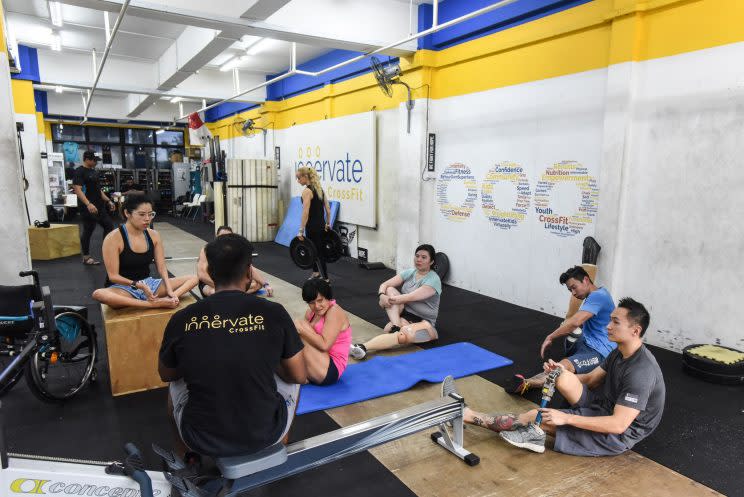Adaptive CrossFit offers challenging workout for those with disabilities
Walking forward slowly, Wan Wai Yee is guided by her coach to the squat bar. Once there she grips the bar tight, positions it on her shoulders, and then proceeds to do a series of squats.
This may sound like part of a regular gym routine but there is one difference: 44-year-old Wan is completely blind. Her exercise partner, Stuart Francis – who is standing by a nearby wall and giving her encouragement – is also visually impaired. As Wan does her workout, there are also amputees around her performing handstand push-ups.
Welcome to the Innervate CrossFit gym, one of the first CrossFit gyms in Singapore to offer adaptive CrossFit for people with disabilities.
Moses James, one of the coaches who leads the adaptive CrossFit sessions, said Innervate CrossFit has a programme for almost every demographic and that they wanted to see if they could offer their services to people with disabilities.
“I was thinking about how else we could better reach out and help, and realised that this (people with disabilities) is actually a group that doesn’t have anything catered to them – locally and possibly in the region,” said the 28-year-old.
An adaptive CrossFit programme uses CrossFit-type movements, with specific adaptations to the equipment to suit the individual’s needs.
“We look at the movement function, in terms of pulling movements, pushing movements – whether it’s lifting something from the ground, or pressing something up overhead – and we make modifications specific to the individual to help them develop those functions,” explained James.
Adaptive CrossFit is well established overseas in places like the US, where programmes are catered for injured war veterans. Locally, however, the scene is still lacking, said James.
He began his research and took part in the Project This Ability Para-sports Day event held at the Enabling Village in March. Innervate’s booth at the event allowed them to reach out to the community and build a following from there.

‘Not fit enough’
Building an acceptance for adaptive CrossFit has also not been easy. James said most of the people with disabilities whom he spoke to needed a bit of convincing before they fully understood the programme and how it is conducted.
“Most of the Adaptive athletes or persons with disabilities were not so sure if they could do it. They said that it looked too tough or they are not fit enough, or it’s not for me,” he recalled.
“These are actually the same apprehensions… able-bodied people have with CrossFit.”
For the first class on 14 March, there were only two participants – national Paralympians Yip Pin Xiu and Theresa Goh. The classes have since grown quickly through word-of-mouth to an average of 11 or 12 regular attendees.
Wan and Francis, both regulars, said they enjoy the community spirit which they feel is very encouraging.
“The community is great. In the three or four weeks we’ve been coming here, we’ve met a lot of new friends… it doesn’t matter what disability you have,” said Francis.
“We all have our own little challenge, but Moses is very good, because he puts the individual challenge to one side, and focuses on what we all need to get done together. And he’ll build us up together as one big team,” he added.

Challenges ahead
Moses emphasised that the coaching principles for the adaptive athletes are the same as those for the able-bodied ones.
“The coaching principles that we apply, are the same across the board. How we coach adaptive athletes is how we coach everybody, it’s how we coach our seniors, our kids, our teens, it’s the same,” said James.
“The extra consideration with the adaptive athletes is the fact that the particular adaptation… for each individual is unique and so it’s not a (matter of) one size fits all,” he added.
“You need to remember for that person, what that adaptation is, where they’re at, and whether or not they’re progressing.”
With the growing number of participants, the challenge for Innervate now is to reach out to people with disabilities who are inactive and to be able to adapt the exercises for anyone who steps through their door.
“Once I realised that people were coming on board and that they enjoyed it, and it was actually starting to grow, then the challenge shifted to, ‘Okay, I need to be able to adapt for everybody in the same group… in the same class’,” said James.
He hopes to grow the community further and aims to hold an adaptive CrossFit competition in less than five years, to encourage people with disabilities to exercise and get active.
“I think having such events, competitions or whatever it may be, on a larger scale for this group of people is going to help grow that demographic and help them understand that there is really a community… over here for them to be a part of.”
Other fitness stories:
Running tips: Perfecting your running form
Running tips: Strength exercises
Self-defence with Rafael Dos Anjos: What to do if you’re grabbed from behind


